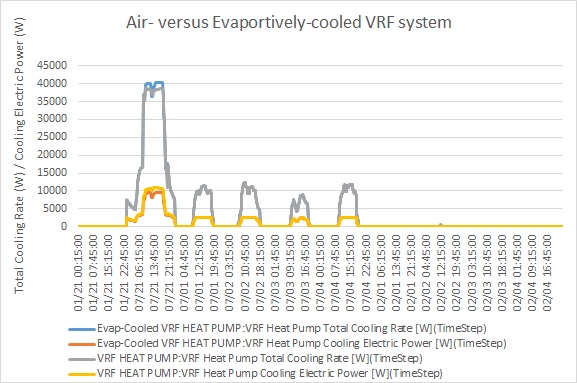First time here? Check out the Help page!
 | 1 | initial version |
I do see differences when modeling the evap-cooled VRF system. I started with the example file VariableRefrigerantFlow_5Zone.idf and ran the simulation. Then I modified that file to model an evaporatively-cooled VRF condenser. The changes made are shown below.
AirConditioner:VariableRefrigerantFlow,
VRF Heat Pump, !- Heat Pump Name
...snip...
EvaporativelyCooled, !- Condenser Type
...snip...
0.9, !- Evaporative Condenser Effectiveness {dimensionless}
autosize, !- Evaporative Condenser Air Flow Rate {m3/s}
20, !- Evaporative Condenser Pump Rated Power Consumption {W}
The differences I see are related to the available cooling capacity and associated condenser power which I would expect. The terminal units have the same load, so I would not expect that equipment to change much (I didn't check that data). Here is a comparison of the results:

 | 2 | No.2 Revision |
I do see differences when modeling the evap-cooled VRF system. I started with the example file VariableRefrigerantFlow_5Zone.idf and ran the simulation. Then I modified that file to model an evaporatively-cooled VRF condenser. The changes made are shown below.
AirConditioner:VariableRefrigerantFlow,
VRF Heat Pump, !- Heat Pump Name
...snip...
EvaporativelyCooled, !- Condenser Type
...snip...
0.9, !- Evaporative Condenser Effectiveness {dimensionless}
autosize, !- Evaporative Condenser Air Flow Rate {m3/s}
20, !- Evaporative Condenser Pump Rated Power Consumption {W}
The differences I see are related to the available cooling capacity and associated condenser power which I would expect. The available cooling capacity should increase while the operating power should decrease, both a result of cooler temperatures entering the condenser. Also, this change would not require new performance curves since the only change modeled here is slightly cooler temperatures entering the condenser, which the performance curves should model. The terminal units have the same load, so I would not expect that equipment to change much (I didn't check that data). Here is a comparison of the results:

